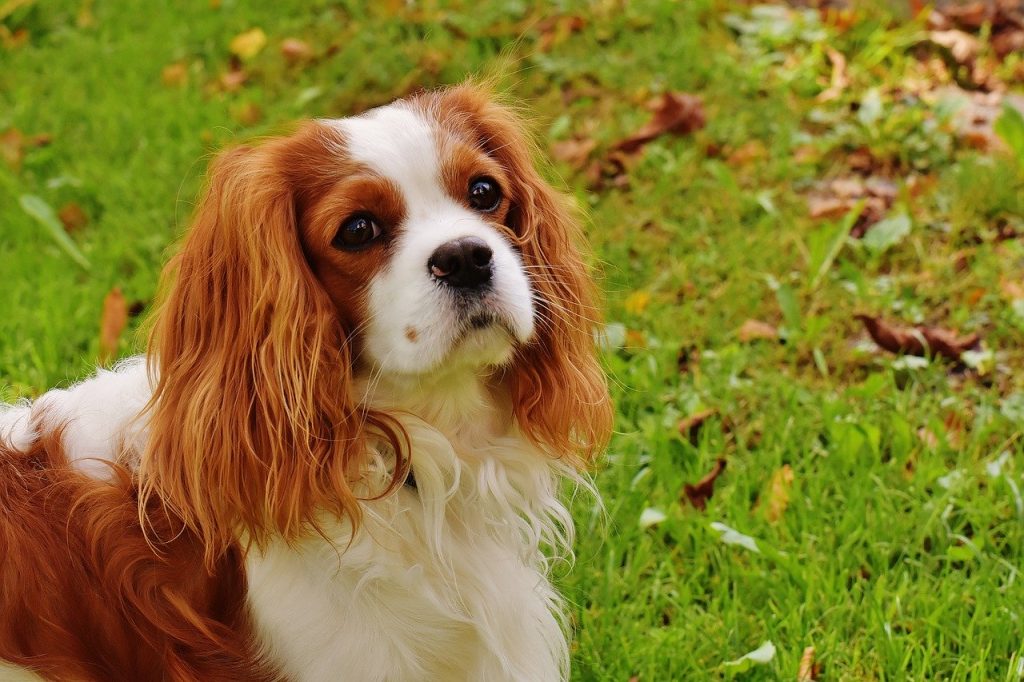Overview
Group: Toy Group
AKC Breed Popularity Rank: No. 18 of 195
Height: 12-13 inches
Weight: 13-18 lbs
Life Span: 12-15 years
Temperament: Gentle; Loving; Graceful
The Cavalier King Charles Spaniel is undoubtedly one of the most beautiful dogs that a dog lover can ever own. Indeed, it is the embodiment of class and nobility, with its silky, long-flowing coat. And yet these lovable toy dogs are playful and energetic, sure to keep you and your kids happy.
History
Since the Renaissance Period, Toy Spaniels were exclusively bred as lap dogs for the nobility. Notable among them were King Charles and King Charles II in 17th century England, who developed a black and tan variation of the dog. By the 19th century, red and white variations were developed by the Marlborough family residing in Blenheim Palace. During the reign of Queen Victoria, these toy spaniels were crossed with Asian toy dogs, reportedly Japanese Chins and Pugs, which resulted in the creation of the English Toy Spaniel or King Charles Spaniel. With its domed skull and flat face, this breed dominated the Old Restoration Type, almost causing them to become extinct.
But then, in 1920s, rich American businessman Roswell Eldridge did not see the “long-nosed spaniels” that were painted in the portraits of English nobles. As an incentive to English breeders, he offered a cash prize of $2,500 (a lot of money back then!) for the breeding of “Blenheim Spaniels of the Old World Type”. This led to the revival of the old variation of the toy spaniel, which was soon named the Cavalier King Charles Spaniel.
Cavaliers are among the favorite dogs of celebrities, including Frank Sinatra, Ronald Reagan, Diane Sawyer, Mickey Rooney, and Courteney Cox.
General Appearance
Cavaliers are characterized by their silky, wavy, rich-colored coats. The four main coat colors of the Cavalier are Blenheim (chestnut marks on a white body), Tricolor, Ruby (rich red all over), and Black and Tan. Its head is of proportionate size, with a short muzzle and a lozenge mark at the top of its head. It has expressive, large, round eyes and high set, pendant ears. Because of the length of their fur, you can see feathering on the backs of its legs.
Cavaliers are happy little dogs. They are very friendly, eager to please, and absolutely love children, except for unruly youngsters. When excited, they have a tendency to be yappy.
Nutrition
It is recommended that Cavaliers be fed home prepared meals or commercially-prepared frozen, canned, or freeze-dried dog foods due to their human-grade real meat content. Dry dog foods are not recommended because of their higher carbohydrate content.
Cavaliers are prone to obesity so always remember to give treats in moderation. To keep your dog’s heart healthy, ask your veterinarian about cardiac supplements that you can give to your Cavalier.
Grooming
The Cavalier’s silky coat needs to be brushed on a daily basis. Not only does it help to maintain the coat’s shine and prevent tangles and matting, brushing acts like a whole- body massage that will stimulate the release of skin oils as well as relax your dog. Make it a point to inspect your dog’s skin for rashes, lumps, and other skin problems.
The ears should also be cleaned and inspected weekly for signs of infection. Trim the nails once a month to prevent pain and structural problems in your dog’s feet.
Exercise
Cavaliers need moderate exercise in the form of 30-minute walks or jogs with the owner. Always remember to keep your dog on a leash or in a harness when taking them out. Or let them play in your fenced back yard. Cavaliers possess hunting and scenting instincts and may suddenly run off in pursuit of potential prey.
Training
Same as other dog breeds, Cavaliers are best started on obedience training and socialization classes when they are still puppies. These classes will help them to learn good manners when with people or other animals. Thankfully, the dog is easy to train and can excel in canine sports, like agility, obedience, and rally.
If you have a sick family member, you may let your Cavalier undergo further training to become a therapy dog.
Health
Cavaliers are at risk of developing heart conditions, like mitral valve heart disease, early in life. They can also develop eye and ear problems, diabetes, hip dysplasia, patella luxation, middle ear infections, and syringomyelia.
Have your dog regularly checked by your veterinarian for these medical conditions
Costs
The Cavalier is one of the most expensive breeds to own. The average cost of a puppy is $1,200, but top-quality dogs can go for $2,200 to $10,000. Medical costs alone are estimated at $1,350 yearly. For this reason, owners are strongly advised to watch out for their dog’s health and well-being.
Despite the huge cost in caring for a Cavalier King Charles Spaniel, the love and affection that this precious dog accords its owner/s is truly priceless.
SOURCES:
1) Cavalier King Charles Spaniel https://www.akc.org/dog-breeds/cavalier-king-charles-spaniel/
2) Vintage Cavaliers Breed History http://www.vintagecavaliers.net/html/vintage_cavaliers_-_breed_hist.html
3) 14 Celebrities with Cavalier King Charles Spaniels https://buzzsharer.com/2015/09/01/14-celebrities-with-cavalier-king-charles-spaniels/
4) Diets for Cavalier King Charles Spaniels https://cavalierhealth.org/diets.htm
5) Most Expensive Dog Breeds https://www.gobankingrates.com/saving-money/pets/most-expensive-dog-breeds/
6) Cavalier King Charles Spaniel Puppies for Sale https://www.nextdaypets.com/Cavalier-King-Charles-Spaniel.htm


